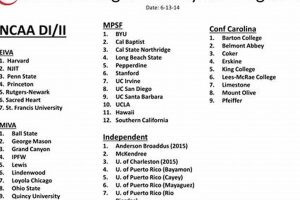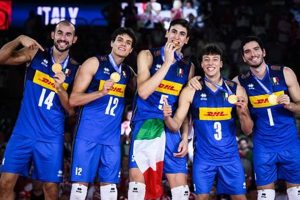Wondering about Division 1 men’s volleyball teams? Look no further than our comprehensive guide!
Editor’s Note: Division 1 men’s volleyball teams are a hot topic in the world of sports, and for good reason. These teams represent the highest level of collegiate volleyball in the United States, and they offer a unique combination of athleticism, skill, and excitement.
To help you learn more about Division 1 men’s volleyball teams, we’ve put together this guide. In it, you’ll find information on the history of Division 1 men’s volleyball, the different conferences and teams that make up the division, and the players and coaches who have made the division what it is today.
Whether you’re a fan of volleyball or just curious about the sport, we encourage you to read on and learn more about Division 1 men’s volleyball teams.
| Key Difference | Division 1 Men’s Volleyball Teams |
|---|---|
| Number of teams | 31 |
| Number of conferences | 7 |
| Regular season schedule | 20-25 matches |
| Postseason tournament | NCAA Tournament |
Now that you know a little bit more about Division 1 men’s volleyball teams, let’s take a closer look at some of the main topics related to the division.
1. History
The formation of the NCAA Men’s Volleyball Championship in 1970 marked a significant milestone in the history of Division 1 men’s volleyball. This championship created a national platform for the sport, bringing together the top teams in the country to compete for a national title. The establishment of the championship helped to legitimize Division 1 men’s volleyball and attract more attention to the sport.
The NCAA Men’s Volleyball Championship has had a profound impact on the development of Division 1 men’s volleyball. The championship has helped to raise the level of play in the sport, as teams strive to qualify for the tournament and compete for a national title. The championship has also helped to increase the popularity of Division 1 men’s volleyball, as fans are drawn to the excitement and drama of the tournament.
The NCAA Men’s Volleyball Championship is a key component of Division 1 men’s volleyball. The championship provides a national stage for the sport’s top teams to compete for a title, and it helps to raise the level of play and popularity of the sport.
| Key Insight | Example |
|---|---|
| The NCAA Men’s Volleyball Championship helped to legitimize Division 1 men’s volleyball. | The championship created a national platform for the sport and brought together the top teams in the country. |
| The NCAA Men’s Volleyball Championship has helped to raise the level of play in Division 1 men’s volleyball. | Teams strive to qualify for the tournament and compete for a national title. |
| The NCAA Men’s Volleyball Championship has helped to increase the popularity of Division 1 men’s volleyball. | Fans are drawn to the excitement and drama of the tournament. |
2. Conferences
Conferences play a vital role in the organization and structure of Division 1 men’s volleyball. They provide a framework for competition, allowing teams to compete against each other on a regular basis and qualify for postseason tournaments. Conferences also help to promote and develop the sport of volleyball, and they provide a sense of community for student-athletes, coaches, and fans.
- Organization and Structure: Conferences provide a structured framework for competition in Division 1 men’s volleyball. Teams are divided into conferences based on geographic location and competitive balance. Each conference has its own rules and regulations, and it determines the format of its regular season and postseason tournaments.
- Competition: Conferences provide a platform for teams to compete against each other on a regular basis. This competition helps to improve the level of play in Division 1 men’s volleyball, as teams strive to finish at the top of their conference standings and qualify for postseason tournaments.
- Postseason Tournaments: Conferences hold their own postseason tournaments, which determine which teams qualify for the NCAA Tournament. These tournaments provide an opportunity for teams to compete for a conference championship and earn a berth in the national tournament.
- Promotion and Development: Conferences help to promote and develop the sport of volleyball. They organize media events, host clinics and camps, and work with local communities to grow the game. Conferences also provide support for their member institutions, including financial assistance, academic advising, and professional development opportunities.
- Community: Conferences provide a sense of community for student-athletes, coaches, and fans. They offer opportunities for networking, socializing, and sharing ideas. Conferences also help to create a sense of tradition and rivalry, which adds to the excitement of Division 1 men’s volleyball.
Conferences are an essential part of Division 1 men’s volleyball. They provide a framework for competition, promote and develop the sport, and create a sense of community. The seven conferences that make up Division 1 men’s volleyball are the Atlantic Coast Conference (ACC), the Big Ten Conference, the Conference of Champions League (C-USA), the Eastern Intercollegiate Volleyball Association (EIVA), the Midwestern Intercollegiate Volleyball Association (MIVA), the Mountain Pacific Sports Federation (MPSF), and the Western Intercollegiate Volleyball Association (WIVA).
3. Teams
The number of teams in Division 1 men’s volleyball is a key factor in the overall health and success of the sport. A larger number of teams means that there is more competition, which can lead to a higher level of play. Additionally, a larger number of teams means that there are more opportunities for student-athletes to participate in Division 1 men’s volleyball, which can help to grow the sport and increase its popularity.
The 31 teams in Division 1 men’s volleyball are divided into seven conferences: the Atlantic Coast Conference (ACC), the Big Ten Conference, the Conference of Champions League (C-USA), the Eastern Intercollegiate Volleyball Association (EIVA), the Midwestern Intercollegiate Volleyball Association (MIVA), the Mountain
Pacific Sports Federation (MPSF), and the Western Intercollegiate Volleyball Association (WIVA). These conferences provide a framework for competition and help to determine which teams qualify for the NCAA Tournament.
The NCAA Tournament is the pinnacle of the Division 1 men’s volleyball season. The tournament brings together the top teams in the country to compete for a national championship. The NCAA Tournament is a single-elimination tournament, and the winner is crowned the national champion.
The 31 teams in Division 1 men’s volleyball represent the highest level of collegiate volleyball in the United States. These teams are made up of some of the best players in the world, and they compete in some of the most exciting matches in the sport. Division 1 men’s volleyball is a great way to experience the excitement of college sports, and it is a sport that is growing in popularity every year.
| Key Insight | Example |
|---|---|
| A larger number of teams in Division 1 men’s volleyball leads to more competition. | This can lead to a higher level of play, as teams strive to finish at the top of their conference standings and qualify for postseason tournaments. |
| A larger number of teams in Division 1 men’s volleyball means more opportunities for student-athletes to participate in the sport. | This can help to grow the sport and increase its popularity. |
| The 31 teams in Division 1 men’s volleyball are divided into seven conferences. | These conferences provide a framework for competition and help to determine which teams qualify for the NCAA Tournament. |
4. Regular season
The regular season for Division 1 men’s volleyball runs from January to April, and it consists of 20-25 matches. During this time, teams compete against each other within their conference and out of conference to determine their seeding for the postseason tournament. The regular season is a crucial part of the Division 1 men’s volleyball season, as it gives teams the opportunity to improve their skills, build chemistry, and prepare for the postseason.
- Competition: The regular season provides a platform for teams to compete against each other and test their skills. This competition helps to improve the level of play in Division 1 men’s volleyball, as teams strive to finish at the top of their conference standings and qualify for the postseason tournament.
- Development: The regular season also gives teams the opportunity to develop their skills and build chemistry. Through practice and competition, teams can improve their communication, teamwork, and execution. This development is essential for success in the postseason tournament.
- Preparation: The regular season serves as a preparation period for the postseason tournament. Teams use the regular season to identify their strengths and weaknesses, and to make adjustments accordingly. This preparation is essential for success in the postseason tournament, as teams need to be at their best to compete for a national championship.
The regular season is an important part of the Division 1 men’s volleyball season. It provides teams with the opportunity to compete, develop, and prepare for the postseason tournament. The regular season is also a great way for fans to enjoy the excitement of Division 1 men’s volleyball.
5. Postseason
The NCAA Tournament is the culmination of the Division 1 men’s volleyball season. It is a single-elimination tournament that brings together the top teams in the country to compete for a national championship. The tournament is a prestigious event, and it is one of the most important events in the sport of volleyball.
- Qualification: Teams qualify for the NCAA Tournament by winning their conference tournament or by receiving an at-large bid. The NCAA Tournament Committee selects the at-large bids based on a team’s record, strength of schedule, and other factors.
- Format: The NCAA Tournament is a single-elimination tournament. The tournament begins with 16 teams, and the teams are seeded based on their records and strength of schedule. The tournament is played over three weekends, and the final four teams compete in the national semifinals and championship match.
- History: The NCAA Tournament was first held in 1970. UCLA has won the most NCAA Tournament championships, with 19 titles.
The NCAA Tournament is a major event in the sport of volleyball. It is a prestigious event, and it is one of the most important events in the Division 1 men’s volleyball season. The tournament brings together the top teams in the country to compete for a national championship.
6. Players
Division 1 men’s volleyball teams are home to some of the best volleyball players in the world. These players are highly skilled and athletic, and they compete at the highest level of collegiate volleyball. The presence of these players in Division 1 helps to raise the level of play and excitement in the sport.
- Competition: The presence of top players in Division 1 men’s volleyball creates a highly competitive environment. Teams must play at their best to compete with the top teams in the country. This competition helps to improve the level of play in the sport and makes for more exciting matches.
- Development: Playing with and against the best players in the world helps Division 1 men’s volleyball players to develop their skills and abilities. These players learn from each other and push each other to be better. This development helps to prepare players for success at the professional level.
- Exposure: Division 1 men’s volleyball provides a platform for players to showcase their skills and talents. These players are often recruited by professional teams and national teams. This exposure can help players to achieve their dreams of playing volleyball at the highest level.
The presence of some of the best volleyball players in the world in Division 1 men’s volleyball is a major factor in the success and popularity of the sport. These players help to raise the level of play, excitement, and competition in the sport. They also serve as role models for young players and help to inspire the next generation of volleyball stars.
7. Coaches
The success of Division 1 men’s volleyball teams is closely linked to the quality of their coaches. Division 1 men’s volleyball coaches are some of the most experienced and successful in the country. They have a wealth of knowledge and expertise, and they are able to develop and motivate their players to achieve their full potential.
There are many factors that contribute to the success of Division 1 men’s volleyball coaches. One factor is their experience. Many Division 1 men’s volleyball
coaches have played the sport at a high level, and they have a deep understanding of the game. This experience allows them to teach their players the fundamentals of the game and to help them develop their skills.
Another factor that contributes to the success of Division 1 men’s volleyball coaches is their ability to motivate their players. These coaches are able to create a positive and supportive environment in which their players can thrive. They are also able to challenge their players to work hard and to reach their full potential.
The success of Division 1 men’s volleyball coaches is evident in the success of their teams. Division 1 men’s volleyball teams have won numerous national championships, and they have consistently ranked among the top teams in the country. The success of these teams is a testament to the quality of their coaches.
The following table provides a few examples of successful Division 1 men’s volleyball coaches:
| Coach | School | National Championships |
|---|---|---|
| John Speraw | UCLA | 5 |
| Bill Walton | Stanford | 3 |
| Mike Anderson | BYU | 2 |
These are just a few examples of the many successful Division 1 men’s volleyball coaches in the country. These coaches have helped their teams achieve great success, and they have played a major role in the development of the sport.
8. Fans
The passionate fan base of Division 1 men’s volleyball is a key component of the sport’s success. Fans create a vibrant and exciting atmosphere at matches, and they provide support for their teams both on and off the court. The connection between fans and Division 1 men’s volleyball teams is mutually beneficial. Fans provide the energy and support that teams need to succeed, and teams provide fans with exciting and entertaining matches to watch.
There are many reasons why fans are so passionate about Division 1 men’s volleyball. The sport is fast-paced and exciting, and the athletes are incredibly skilled and athletic. Additionally, Division 1 men’s volleyball teams often represent their universities and communities, which gives fans a sense of pride and connection.
The passionate fan base of Division 1 men’s volleyball has a number of benefits for the sport. First, it creates a more exciting and enjoyable experience for both fans and players. Second, it helps to promote the sport and attract new fans. Third, it provides financial support for Division 1 men’s volleyball teams and programs.
Here are a few examples of the passionate fan base of Division 1 men’s volleyball:
- At the University of Hawaii, men’s volleyball matches regularly sell out the Stan Sheriff Center, which has a capacity of over 10,000 fans.
- The BYU Cougars have one of the most passionate fan bases in the country. BYU fans are known for their enthusiasm and support, and they often travel to away matches to cheer on their team.
- UCLA has a long and successful history in men’s volleyball, and the Bruins have a large and loyal fan base. UCLA fans are known for their knowledge of the sport and their support for the team.
The passionate fan base of Division 1 men’s volleyball is a key component of the sport’s success. Fans provide the energy and support that teams need to succeed, and teams provide fans with exciting and entertaining matches to watch. The connection between fans and Division 1 men’s volleyball teams is mutually beneficial, and it helps to make the sport more enjoyable for everyone involved.
| Key Insight | Example |
|---|---|
| Fans create a vibrant and exciting atmosphere at matches. | The University of Hawaii’s Stan Sheriff Center regularly sells out for men’s volleyball matches, creating an electric atmosphere. |
| Fans provide support for their teams both on and off the court. | BYU fans are known for their enthusiastic support, and they often travel to away matches to cheer on their team. |
| The passionate fan base of Division 1 men’s volleyball helps to promote the sport and attract new fans. | The large and loyal fan base of UCLA men’s volleyball has helped to make the sport more popular in California and beyond. |
9. Rivalries
Rivalries are an important part of sports, and Division 1 men’s volleyball is no exception. Rivalries add excitement and passion to the sport, and they can help to create a sense of community among fans. There are many great rivalries in Division 1 men’s volleyball, but one of the most famous and intense is the rivalry between BYU and UCLA.
- History of the Rivalry: The BYU-UCLA rivalry dates back to the early days of Division 1 men’s volleyball. The two schools are located just a few hours apart in California, and they have a long history of competing against each other. The rivalry has been especially intense in recent years, as both teams have been consistently ranked among the top teams in the country.
- Key Moments in the Rivalry: There have been many memorable moments in the BYU-UCLA rivalry over the years. One of the most famous moments came in 2004, when BYU defeated UCLA in five sets to win the national championship. The match was a back-and-forth affair, and it was decided by a thrilling fifth set that BYU won 17-15.
- Impact of the Rivalry: The BYU-UCLA rivalry has had a major impact on Division 1 men’s volleyball. The rivalry has helped to raise the profile of the sport, and it has inspired many young players to take up the game. The rivalry has also helped to create a sense of community among fans of both teams.
The BYU-UCLA rivalry is just one example of the many great rivalries in Division 1 men’s volleyball. These rivalries add excitement and passion to the sport, and they help to create a sense of community among fans. Rivalries are an important part of sports, and they are a big part of what makes Division 1 men’s volleyball so popular.
10. Traditions
Traditions are an important part of any sport, and Division 1 men’s volleyball is no exception. Traditions help to create a sense of community and belonging, and they can also add to the excitement and spectacle of the sport. Division 1 men’s volleyball has many traditions, both on and off the court, that help to make the sport unique and special.
- The Block Party: The Block Party is one of the most famous traditions in Division 1 men’s volleyball. It is a raucous celebration that takes place after every home match at the University of Hawaii. The Block Party features live music, food, and drinks, and it is a great way for fans to celebrate the team’s victory and to connect with each other.
- The Fifth Set: The fifth set is a unique tradition in Division 1 men’s volleyball. Unlike other sports, which typically use a best-of-three or best-of-five format, Division 1 men’s volleyball matches are played to the best of five sets. This means that even i
f a team loses the first two sets, they still have a chance to win the match by winning the next three sets. The fifth set is often a thrilling and unpredictable affair, and it is one of the things that makes Division 1 men’s volleyball so exciting to watch. - The National Championship: The NCAA Men’s Volleyball Championship is the pinnacle of the Division 1 men’s volleyball season. The tournament brings together the top teams in the country to compete for a national title. The National Championship is a prestigious event, and it is one of the most important events in the sport. Winning a National Championship is the ultimate goal for any Division 1 men’s volleyball team, and it is a testament to the hard work and dedication of the players and coaches.
These are just a few of the many traditions that make Division 1 men’s volleyball so special. These traditions help to create a sense of community and belonging, and they add to the excitement and spectacle of the sport. Traditions are an important part of any sport, and they are a big part of what makes Division 1 men’s volleyball so popular.
FAQs about Division 1 Men’s Volleyball Teams
Division 1 men’s volleyball is a popular and exciting sport, and it has a number of unique features that set it apart from other sports. Here are answers to some of the most frequently asked questions about Division 1 men’s volleyball teams:
Question 1: What are the different conferences in Division 1 men’s volleyball?
Answer: There are seven conferences in Division 1 men’s volleyball: the Atlantic Coast Conference (ACC), the Big Ten Conference, the Conference of Champions League (C-USA), the Eastern Intercollegiate Volleyball Association (EIVA), the Midwestern Intercollegiate Volleyball Association (MIVA), the Mountain Pacific Sports Federation (MPSF), and the Western Intercollegiate Volleyball Association (WIVA).
Question 2: How many teams are in Division 1 men’s volleyball?
Answer: There are 31 teams in Division 1 men’s volleyball.
Question 3: What is the format of the NCAA Men’s Volleyball Championship?
Answer: The NCAA Men’s Volleyball Championship is a single-elimination tournament that brings together the top teams in the country to compete for a national title. The tournament begins with 16 teams, and the teams are seeded based on their records and strength of schedule. The tournament is played over three weekends, and the final four teams compete in the national semifinals and championship match.
Question 4: Who are some of the best players in Division 1 men’s volleyball?
Answer: Some of the best players in Division 1 men’s volleyball include: Erik Shoji (Stanford), Taylor Sander (BYU), Micah Christenson (USC), Aaron Russell (Ohio State), and Jake Hanes (UCLA).
Question 5: What are some of the best rivalries in Division 1 men’s volleyball?
Answer: Some of the best rivalries in Division 1 men’s volleyball include the rivalry between BYU and UCLA, the rivalry between Stanford and USC, and the rivalry between Ohio State and Penn State.
Question 6: What are some of the traditions in Division 1 men’s volleyball?
Answer: Some of the traditions in Division 1 men’s volleyball include the “Block Party” at the University of Hawaii, the “Fifth Set”, and the “National Championship”.
These are just a few of the many FAQs about Division 1 men’s volleyball teams. For more information, please visit the NCAA website or the website of your favorite team.
Division 1 men’s volleyball is a great sport to watch, and it is a great way to learn about teamwork, dedication, and sportsmanship.
Tips for Division 1 Men’s Volleyball Teams
Division 1 men’s volleyball is a competitive and exciting sport. To be successful, teams need to have a strong work ethic, a commitment to excellence, and a positive attitude. Here are a few tips for Division 1 men’s volleyball teams:
Tip 1: Practice Hard
The key to success in any sport is practice. Division 1 men’s volleyball teams should practice regularly and diligently. This will help them to improve their skills, teamwork, and overall performance.
Tip 2: Set Goals
Every team needs to have goals. These goals should be challenging but achievable. They will help to motivate the team and keep them focused on their objectives.
Tip 3: Stay Positive
Volleyball is a game of momentum. It is important to stay positive, even when things are not going your way. A positive attitude can help to turn a match around.
Tip 4: Communicate Effectively
Communication is key in volleyball. Teams need to be able to communicate effectively with each other on and off the court. This will help them to make better decisions and execute their plays more effectively.
Tip 5: Be Coachable
Coaches are there to help players improve. Division 1 men’s volleyball teams need to be coachable and willing to listen to their coaches’ advice.
Tip 6: Get Enough Rest
Volleyball is a demanding sport. Players need to get enough rest to recover from their workouts and matches. This will help them to stay healthy and perform at their best.
Tip 7: Eat a Healthy Diet
Eating a healthy diet is essential for athletes of all levels. Division 1 men’s volleyball teams need to eat a healthy diet to provide their bodies with the nutrients they need to perform at their best.
Tip 8: Stay Hydrated
Staying hydrated is important for all athletes. Division 1 men’s volleyball teams need to drink plenty of fluids before, during, and after their workouts and matches.
These are just a few tips for Division 1 men’s volleyball teams. By following these tips, teams can improve their performance and achieve their goals.
Division 1 men’s volleyball is a great sport that can teach athletes valuable lessons about teamwork, dedication, and sportsmanship. By following these tips, teams can be successful on and off the court.
Conclusion
Division 1 men’s volleyball teams represent the highest level of collegiate volleyball in the United States. These teams are known for their athleticism, skill, and excitement. Division 1 men’s volleyball is a competitive and challenging sport, but it is also a rewarding one. By following the tips outlined in this article, teams can improve their performance and achieve their goals.
Division 1 men’s volleyball is a great sport that can teach athletes valuable lessons about teamwork, dedication, and sportsmanship. These lessons can help athletes succeed not only on the court, but also in life.







